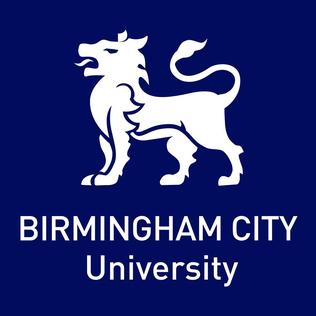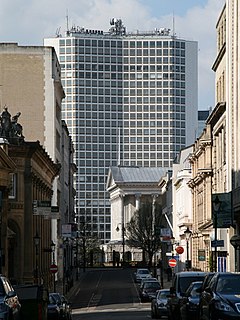
Aston University is a public research university situated in the city centre of Birmingham, England. Aston began as the Birmingham Municipal Technical School in 1895, evolving into the UK's first College of Advanced Technology in 1956. Aston University received its royal charter from Queen Elizabeth II on 22 April 1966.

West Bromwich is a market town in the borough of Sandwell, West Midlands, England. Historically part of Staffordshire, it is 6.4 miles (10.3 km) north-west of Birmingham. West Bromwich is part of the area known as the Black Country, in terms of geography, culture and dialect. West Bromwich had a population of 77,997 in 2011 Census.

Aston is an area of inner Birmingham, England. Located immediately to the north-east of Central Birmingham, Aston constitutes a ward within the metropolitan authority. It is approximately 1.5 miles from Birmingham City Centre.

Birmingham City University is a university in Birmingham, England. Initially established as the Birmingham College of Art with roots dating back to 1843, it was designated as a polytechnic in 1971 and gained university status in 1992.

Wilmslow Road is a major road in Manchester, England, running from Parrs Wood northwards to Rusholme. There it becomes Oxford Road and the name changes again to Oxford Street when it crosses the River Medlock and reaches the city centre.

Although Birmingham in England has existed as a settlement for over a thousand years, today's city is overwhelmingly a product of the 18th, 19th, and 20th centuries, with little surviving from its early history. As it has expanded, it has acquired a variety of architectural styles. Buildings of most modern architectural styles in the United Kingdom are located in Birmingham. In recent years, Birmingham was one of the first cities to exhibit the blobitecture style with the construction of the Selfridges store at the Bullring Shopping Centre.

The culture of Birmingham is characterised by a deep-seated tradition of individualism and experimentation, and the unusually fragmented but innovative culture that results has been widely remarked upon by commentators. Writing in 1969, the New York-based urbanist Jane Jacobs cast Birmingham as one of the world's great examples of urban creativity: surveying its history from the 16th to the 20th centuries she described it as a "great, confused laboratory of ideas", noting how its chaotic structure as a "muddle of oddments" meant that it "grew through constant diversification". The historian G. M. Young – in a classic comparison later expanded upon by Asa Briggs – contrasted the "experimental, adventurous, diverse" culture of Birmingham with the "solid, uniform, pacific" culture of the outwardly similar city of Manchester. The American economist Edward Gleason wrote in 2011 that "cities, the dense agglomerations that dot the globe, have been engines of innovation since Plato and Socrates bickered in an Athenian marketplace. The streets of Florence gave us the Renaissance and the streets of Birmingham gave us the Industrial Revolution", concluding: "wandering these cities ... is to study nothing less than human progress."

Nechells is a district ward in central Birmingham, England, whose population in 2011 was 33,957. It is also a ward within the formal district of Ladywood. Nechells local government ward includes areas, for example parts of Birmingham city centre, which are not part of the historic district of Nechells as such, now often referred to in policy documents as "North Nechells, Bloomsbury and Duddeston".

The Birmingham School of Art was a municipal art school based in the centre of Birmingham, England. Although the organisation was absorbed by Birmingham Polytechnic in 1971 and is now part of Birmingham City University's Faculty of Arts, Design and Media, its Grade I listed building on Margaret Street remains the home of the university's Department of Fine Art and is still commonly referred to by its original title.

Eastside is a district of Birmingham City Centre, England that is undergoing a major redevelopment project. The overall cost when completed is expected to be £6–8 billion over ten years which will result in the creation of 12,000 jobs. 8,000 jobs are expected to be created during the construction period. It is part of the larger Big City Plan project.
The Aston Hippodrome, also known as The Hipp, was a popular theatre in the Aston area of Birmingham, England.
This article is intended to show a timeline of events in the History of Birmingham, England, with a particular focus on the events, people or places that are covered in Wikipedia articles.

Birmingham is a major city and metropolitan borough in the West Midlands, England. It is the UK’s largest and most populated metropolitan borough, standing as the ‘Core City’ within the second-largest metropolitan area and third-largest urban area in the United Kingdom, with roughly 1.2 million inhabitants within the borough (city-proper) area, 2.8 million inhabitants within the urban area and 4.3 million inhabitants within the larger metropolitan area. Birmingham is commonly referred to as the "second city of the United Kingdom".

The Aston Triangle is an area of Birmingham City Centre, England. The area is mostly dominated by higher education facilities. Aston University is based within the Aston Triangle area and the logo of the establishment takes from the shape of the area. Birmingham City University also uses facilities on the Aston University campus. These are in Gosta Green together with Birmingham Institute of Art and Design and Aston Science Park. The site has large numbers of teaching buildings and student halls of residence, which are used by Aston University. Dalton, Lawrence, and Stafford Towers, three large towers containing student dwellings, were demolished in the early 2010s, and new student accommodation named the William Murdoch, the James Watt, the Harriet Martineau and the Mary Sturge Residences constructed.

The Birmingham Arts Laboratory or Arts Lab was an experimental arts centre and artist collective based in Birmingham, England from 1968 to 1982 – an "arts and performance space dedicated to radical research into art and creativity". Loosely organised and biased towards the obscure and avant-garde, it was described by The Guardian in 1997 as "one of the emblematic institutions of the 1960s".

The Union Chapel, also known as the Union Street Chapel, Elim Free Church, Four Square Gospel Tabernacle or Elim Tabernacle of the Four Square Gospel, is a former chapel in the centre of Brighton, a constituent part of the city of Brighton and Hove, England. After three centuries of religious use by various congregations, the chapel—which had been Brighton's first Nonconformist place of worship—passed into secular use in 1988 when it was converted into a pub. It was redesigned in 1825, at the height of Brighton's Georgian building boom, by at least one of the members of the Wilds–Busby architectural partnership, Brighton's pre-eminent designers and builders of the era, but may retain some 17th-century parts. It has been listed at Grade II in view of its architectural importance.

Birmingham Metropolitan College is a further and higher education college with 10 campuses distributed within Birmingham, England. The college was created in 2009 as an amalgamation of Matthew Boulton College and Sutton Coldfield College. The main site is Matthew Boulton College based at Jennens Road in Birmingham City Centre.

Kings Heath is a suburb of south Birmingham, England, four miles south of the city centre. Historically in Worcestershire, it is the next suburb south from Moseley on the A435, Alcester road.

The Grosvenor Picture Palace, now known as the Footage, is a former cinema and current pub at the corner of Grosvenor Street and Oxford Road in Chorlton-on-Medlock, Manchester, United Kingdom. Built in 1913–15, it was the largest cinema outside London in its day. It is now a Stonegate pub.



















